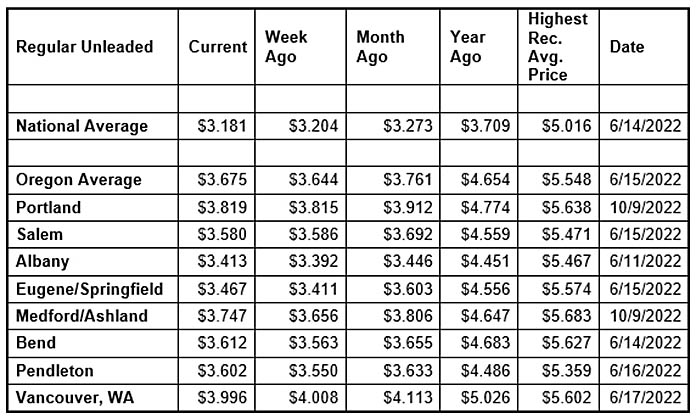Rising tensions in the Middle East have caused crude oil prices to rise, fueling small increases at the pumps in 19 states and slowing the declines in other states.
Meanwhile, Hurricane Milton is expected to thrash Florida this week. Gas prices could see regional increases as drivers top-off vehicles while evacuating. For the week, the national average for regular edges down two cents to $3.18 a gallon.
The Oregon average ticks up three cents to $3.68 a gallon.
Hurricane Milton is expected to make landfall late Wednesday night or early Thursday morning. Gas supplies are expected to tighten in Florida. Depending on the weather prior to the storm’s arrival, fuel deliveries could be reduced, limiting fuel supply at terminals and at local stations. The severity of the storm will determine access to fuel supply and impact on gas prices in Florida and the region following the storm. This should not impact pump prices here in the Pacific Northwest, but could put upward pressure on the national average. As in any national or local state of emergency, AAA expects gas prices to be held in check — up and down the gasoline supply chain — including prices set by refiners, distributors, and dealers.
“U.S. crude oil prices (West Texas Intermediate) climbed above $77 per barrel Monday, but have backed down to around $74 per barrel today. The rally has eased because Israel has not yet retaliated against Iran. However, oil prices will likely remain volatile due to fears of a growing war in the Middle East. WTI had remained in the upper $60s to low $70s for about a month.” says Marie Dodds, public affairs director for AAA Oregon/Idaho. “If crude prices remain elevated, we will likely see upward movement in pump prices.”
The escalating conflict between Israel and Iran may result in Iran’s oil production to be disrupted, which would impact regional and international supplies. Israel may target Iran’s oil infrastructure in retaliation for Iran’s ballistic missile attack on Israel last week. Iran produces about 3.4 million barrels of oil per day. At the same time, OPEC would have enough capacity to make up for the Iranian production. The U.S. currently produces the most crude oil of any nation, according to the U.S. Energy Information Administration.
The Oregon average began 2024 at $3.79 a gallon compared to $3.68 today. Its lowest price so far this year is $3.58 on Feb. 14 and the highest is nearly $4.51 on May 1. The national average started the year at $3.11 and is at $3.18 today. Its lowest price so far this year is just under $3.07 on Jan. 15 and the highest is just under $3.68 on April 19.
This week, only one Oregon county still has an average above $4 a gallon: Wallowa ($4.14).
Gas prices typically drop in the fall, due to the switch from summer-blend to winter-blend fuel, which costs less to produce. The switch starts in September. Many areas, including Oregon, can sell winter-blend fuel starting Sept. 15. However, Northern and Southern California require summer-blend fuel through Oct. 31.
Oregon is one of 19 states and the District of Columbia with higher prices now than a week ago. Virginia (+7 cents) has the biggest week-over-week increase in the nation. Georgia (-23 cents) has the largest weekly decrease.
California ($4.68) has the most expensive gas in the nation for the fifth week in a row. Hawaii ($4.58) is second, and Washington ($4.04) is third. These are the three states with averages at or above $4 a gallon, same as a week ago. This week 31 states and the District of Columbia have averages in the $3-range. There are 16 states with an average in the $2 range this week.
The cheapest gas in the nation is in Mississippi ($2.70) and Georgia ($2.73). No state has had an average below $2 a gallon since January 7, 2021, when Mississippi and Texas were below that threshold.
The difference between the most expensive and least expensive states is $1.98 this week, compared to $2.00 a week ago.
Oregon is one of 46 states and the District of Columbia with lower prices now than a month ago. The national average is nine cents less and the Oregon average is nine cents less than a month ago. Georgia (-34 cents) has the largest month-over-month drop in the nation. Delaware (+10 cents) has the largest monthly increase in the nation.
All 50 states and the District of Columbia have lower prices now than a year ago. The national average is 53 cents less and the Oregon average is 98 cents less than a year ago. This is the fifth-largest year-over-year drop in the nation. Arizona (-$1.18) has the largest year-over-year drop.











